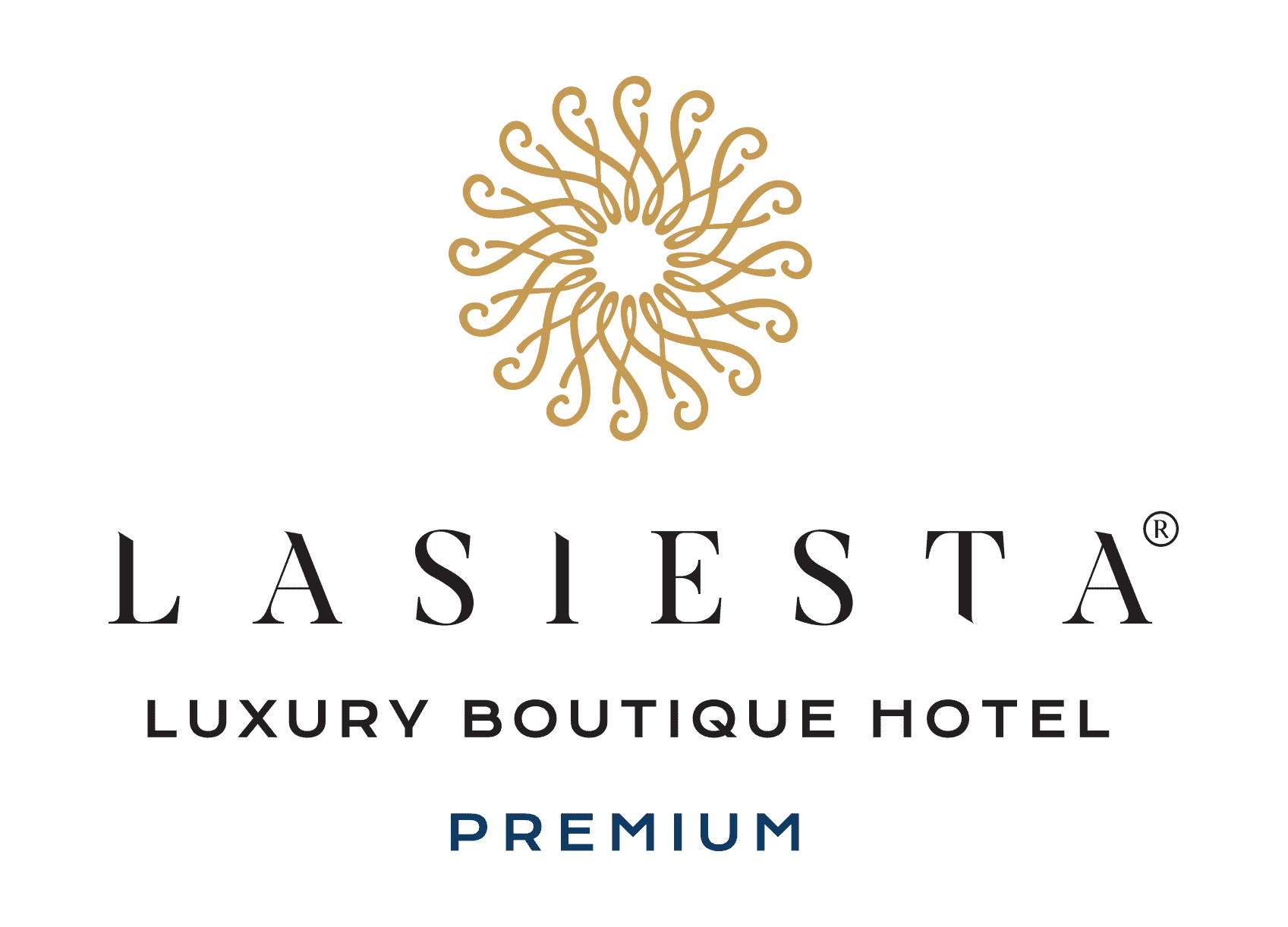Top Attractions in Saigon (Ho Chi Minh City) that you do not want to miss (Part 1)
Ho Chi Minh City (Saigon) is one of the largest tourist centers of Vietnam and has long played a very important role in the culture and economy of the country. The bustling modern city is the top destination for tourists as there are numerous tourist attractions in Ho Chi Minh City.
Ho Chi Minh City and its surroundings boast many impressive tourist destinations that you should not miss during your trip to the largest city in Vietnam. Here is the list of top attractions in Ho Chi Minh City that can be visited to have fun and explore.
1. Notre-Dame Cathedral Basilica of Saigon
Address: No. 1, Commune of Paris, Ben Nghe Ward, District 1, Ho Chi Minh City
Opening hours: morning 8:30 – 10:00, afternoon 14:30 – 15:30 (Monday – Friday)
Entrance fee: Free
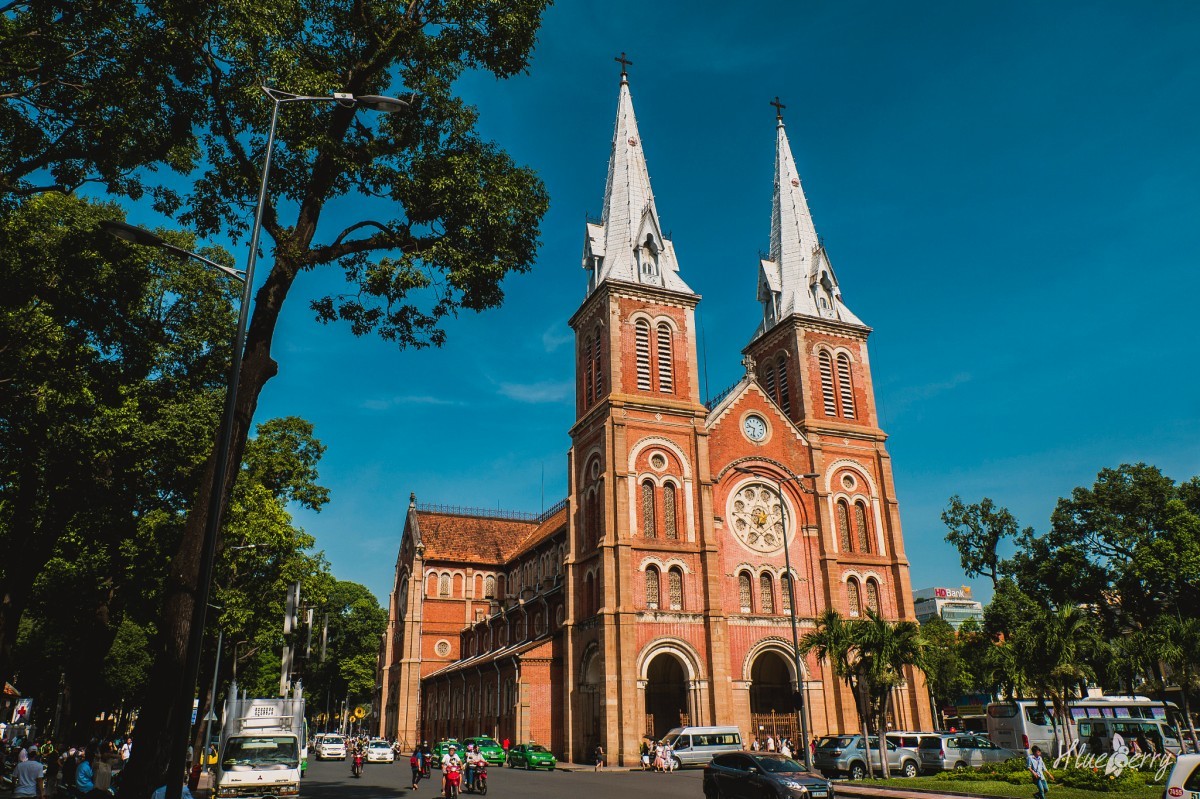
As one of the four Basilicas in Vietnam, Notre-Dame Cathedral is considered an architectural masterpiece, contributing to the urban face and marking the formation and development of Saigon urban. Although it has undergone many impacts, Notre Dame Cathedral Saigon (also known as Immaculate Conception Cathedral Basilica) still retains its value, becoming a work not only of religious significance but also of great significance. is a symbol of the city, a tourist destination that any visitor to Saigon will not forget to visit.
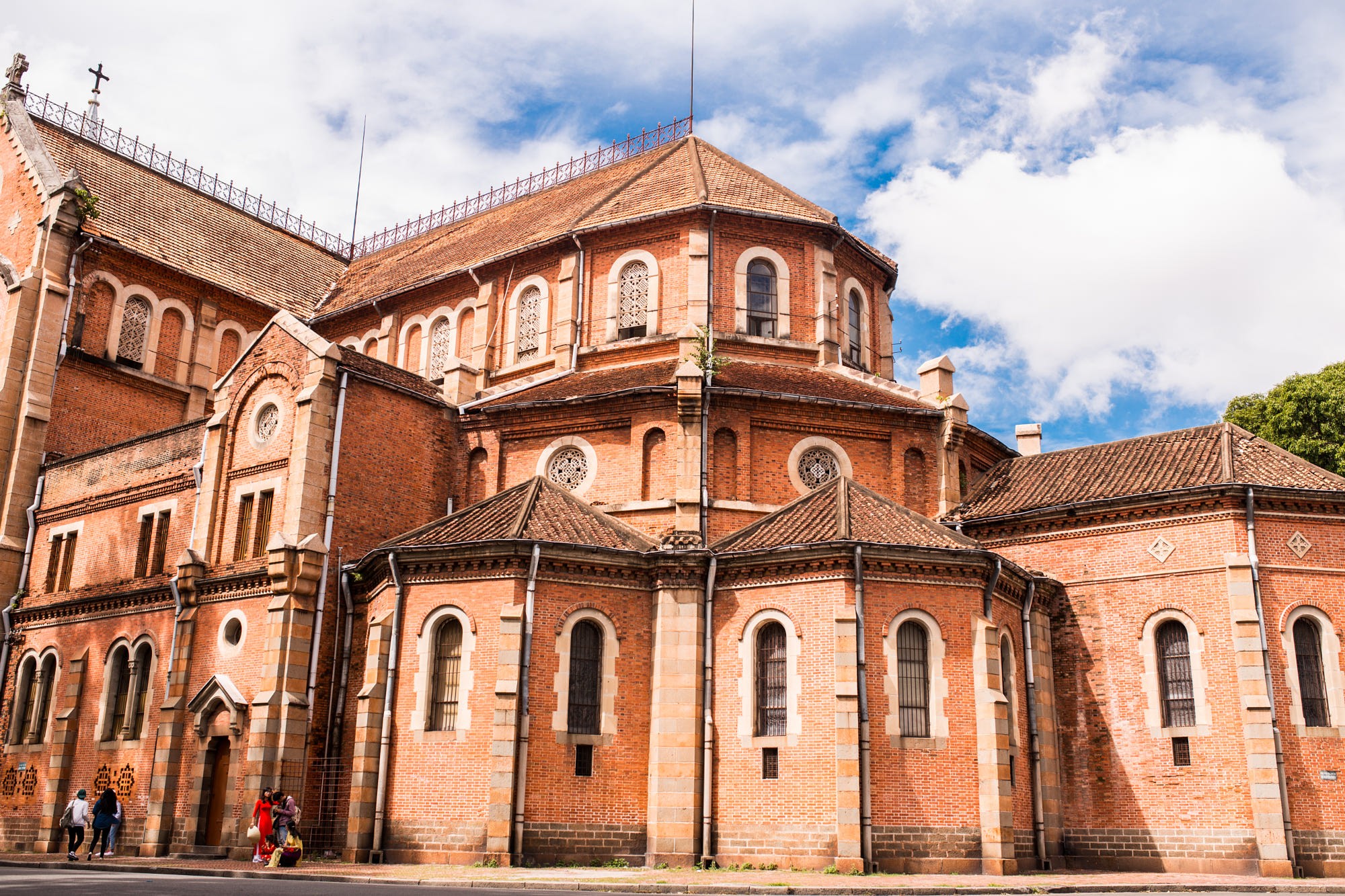
The cathedral was constructed by French colonists in the second half of the 19th century. Notre-Dame Saigon features a luxurious and magnificent European architecture combining romance with Roman and Gothic styles. The most outstanding is the design with pink ceiling tiles saved during the centuries along with a pair of biggest bells in Vietnam. The cathedral area clearly shows the impression of Saigon as it is surrounded by skyscrapers and other modern buildings as well as many other famous places of the city such as Dong Khoi Street and Independence Palace. In front of the church, there is a small park and statue of Our Lady – the symbol of peace and happiness.
2. Saigon Central Post Office
Address: No. 125, Paris Commune, Ben Nghe Ward, District 1, Ho Chi Minh City
Opening hours: 7:00 – 19:00

Saigon Central Post Office with beautiful Renaissance architecture is still preserved until now. It can be seen that the post office is a nostalgic break in the heart of a busy and modern city. One of the things that makes Saigon Central Post Office attract visitors by its meticulous and delicate carvings, the system of large curved arched doorways, etc. The combination of royal European style and European style The liberal Asia makes this place one of the tourist attractions in Saigon that everyone loves.
The Central Post Office was built between 1886 – 1891 by the famous French architect Gustave Eiffel – who is famous for designing the Eiffel Tower, the Statue of Liberty. In 1864, the stork stamp was the first stamp to appear in Vietnam, appearing on letters from Saigon to all over the world.
In 1891, a new post office was officially inaugurated. This place recorded the imprint of Vietnamese – French culture, and witnessed many historical ups and downs. With a unique and sophisticated architecture, Saigon Central Post Office is not only a place of communication and correspondence, but also becomes one of the hot places in Saigon that many young people come to check in and take photos.
3. Independence Palace
Address: 135 Nam Ky Khoi Nghia, District 1, Ho Chi Minh City
Opening hours: 7:30 – 11:00, 13:00 – 16:00 Monday – Friday
Entrance fee: 40,000 VND per person
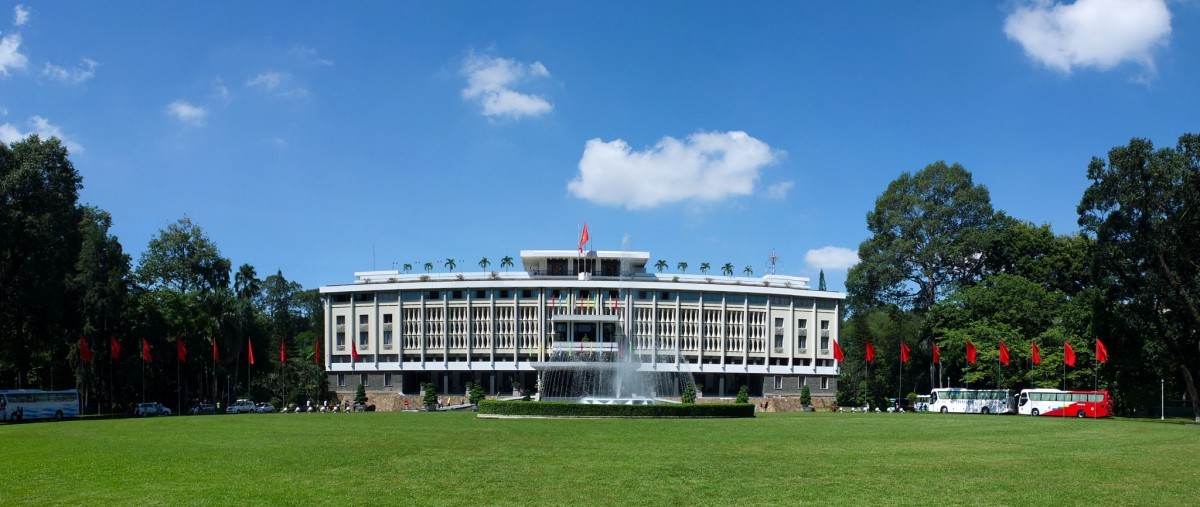
Independence Palace is one of the most unique and famous architectural works in Ho Chi Minh City, which has existed for more than 150 years. The work was built by Mr. La Grandière, the French Governor in South Vietnam, starting construction in 1868 and completed in 1871.
Independence Palace was built on an area of 4,500m2 and has a usable area of up to 20,000m2. The palace has three main floors, two mezzanines, a terrace, two basements, a ground floor and a terrace that is also a helipad. With the ingenious and ingenious design of Architect Ngo Viet Thu, the Independence Palace is a harmonious combination between modern and Asian architecture, especially traditional Vietnamese architecture.
At first, the palace was called Norodom Palace; In 1954, it was changed to Independence Palace. In addition, under the Republic of Vietnam, this building was called the Presidential Palace or the Dragon Palace, because it was the residence and working place of the President of the Republic of Vietnam at that time.
With the special values of the Independence Palace, this work was recognized as a national historical and cultural relic in 1976. In 2009, the Independence Palace was ranked as one of ten special national monuments. Vietnam’s first.
Currently, the Independence Palace is open to people and visitors, and has also welcomed many heads of state as well as high-ranking officials from other countries to visit and admire.
4. Saigon Opera House (Ho Chi Minh City Municipal Theater)
Address: No. 01 Lam Son Square, Ben Nghe Ward, District 1, Ho Chi Minh City
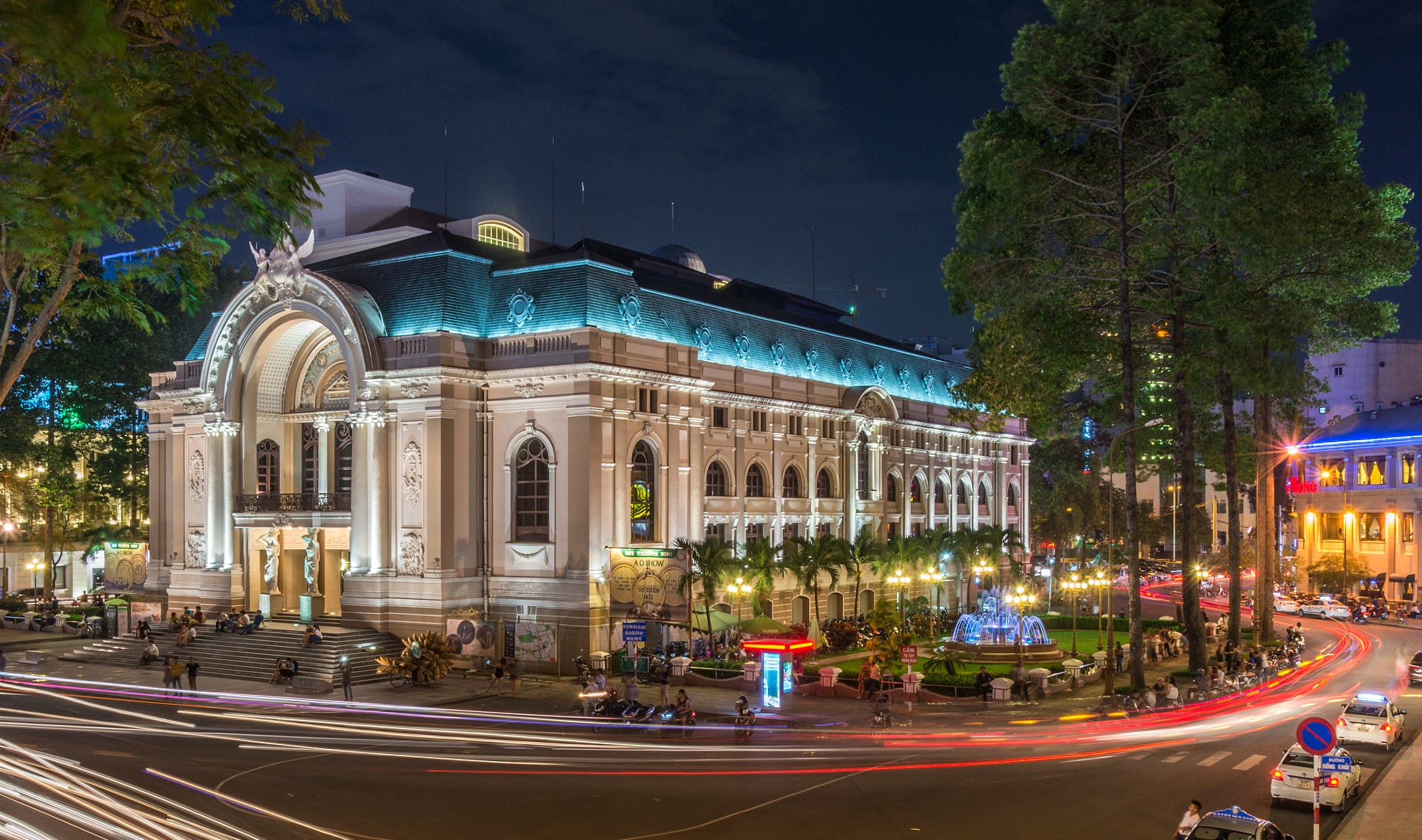
The Ho Chi Minh City Opera House is a special architectural work, bearing the Gothic style prevalent in France at the end of the 19th century. This is considered the central theater, which specializes in organizing artistic theater programs. It is also an interesting tourist destination in Ho Chi Minh City.
After capturing the south, in 1863, the French government in Indochina invited a troupe to perform in Saigon to entertain the French crusaders. In 1898, the Opera House was started and completed two years later. The Ho Chi Minh City Opera House was designed by a group of French architects including Félix Olivier, Eugène Ferret, and Ernest Guichard. The architectural style of the work is characterized by a skillful combination of architecture and sculpture; In which, sculpture decoration is very important, from the outside to the interior, there are many reliefs and embossed statues.
Particularly, the theater’s facade is clearly influenced by the art of the Petit Palais Museum (where many artworks are displayed from the ancient to late 19th century) built in the same year in Paris, France. All decorations, façade reliefs, and interiors of the Saigon Opera House were painted by a famous French artist like the models of theaters in France in the late 19th century.
Experiencing many historical events, the Saigon Opera House was also somewhat damaged. In 1955, the theater was renovated and renovated, but it was used as the headquarters of the National Assembly (later known as the House of Representatives) of the government of the Republic of Vietnam.
After 1975, the theater was restored to its original function as a performing arts organization. On the occasion of 300 years of Saigon – Gia Dinh in 1998, the government of Ho Chi Minh City carried out renovation with the motto of preserving the original architectural style. A犀利士
t this time, the decorations and embossed sculptures in the front of the theater such as the artistic goddess statue, and the flower strings … have been restored compared to the previous status quo for nearly 100 years.
The Opera House is located in the downtown area, making it an ideal spot for tourists to explore. The theater is not only an architectural-cultural work associated with the ups and downs of the city’s history but also a beautiful architectural work, contributing to the charm and elegance of Ho Chi Minh City
5. Nguyen Hue Walking Street
Address: Nguyen Hue Street, Ben Nghe Ward, District 1, Ho Chi Minh City
Opening hours: 24 Hours (the pedestrian street is banned from traffic every Saturday and Sunday)
Entrance fee: Free
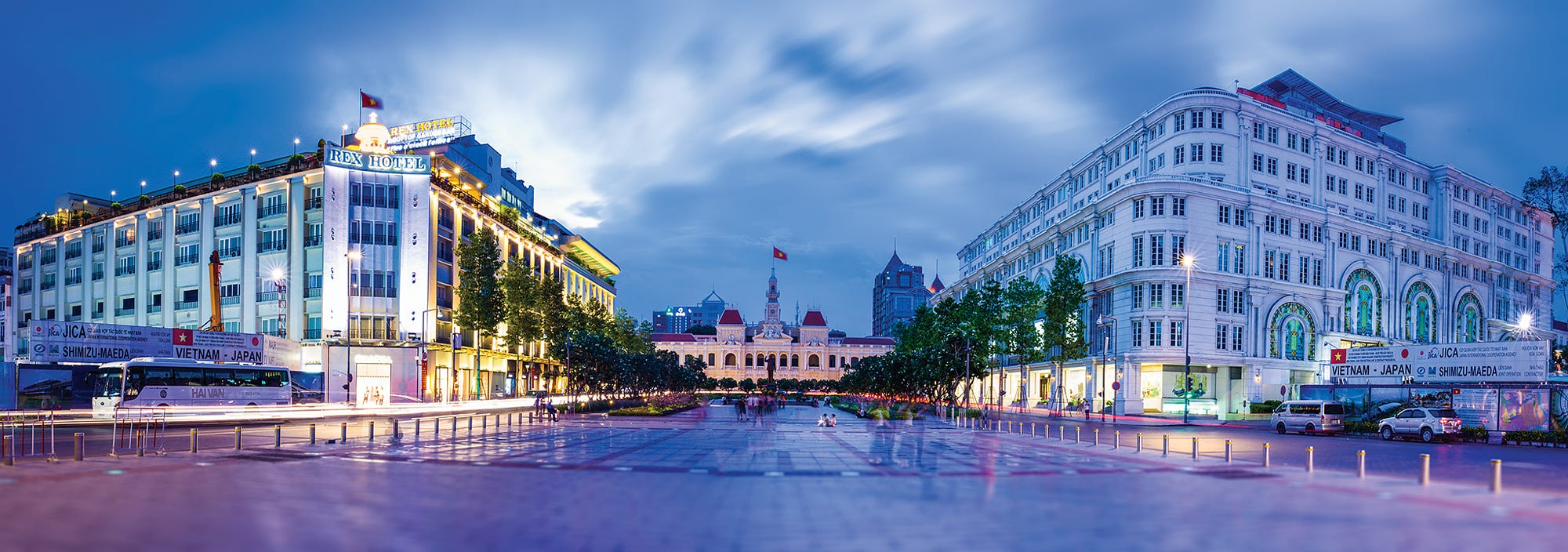
Nguyen Hue Walking Street is located right in the heart of District 1, Ho Chi Minh City. This is one of the latest works of the city completed on the 40th anniversary of the complete liberation of the South and reunification of the country on April 30, 2015. It is a 670 m long and 64 m wide avenue with two large fountains, modern lighting and lots of greenery.
Nguyen Hue pedestrian street is a new highlight in the urban architecture of Ho Chi Minh City, a favorite destination of young people after a tiring working day as well as tourists who love to explore. Evening is the time when Nguyen Hue pedestrian street attracts the most tourists. Looking down from above, Nguyen Hue pedestrian street is crowded, bustling and colorful by the lights. People will be extremely excited when enjoying the water music performance combined with artistic laser lights to create attractive colors for the street. This avenue is also lined up by hotels, cute cafes and restaurants, high-end shopping malls, old-fashioned houses and other famous tourist destinations.
6. Bui Vien Street
Address: Pham Ngu Lao Ward, District 1, Ho Chi Minh City
Opening hours: 24 Hours
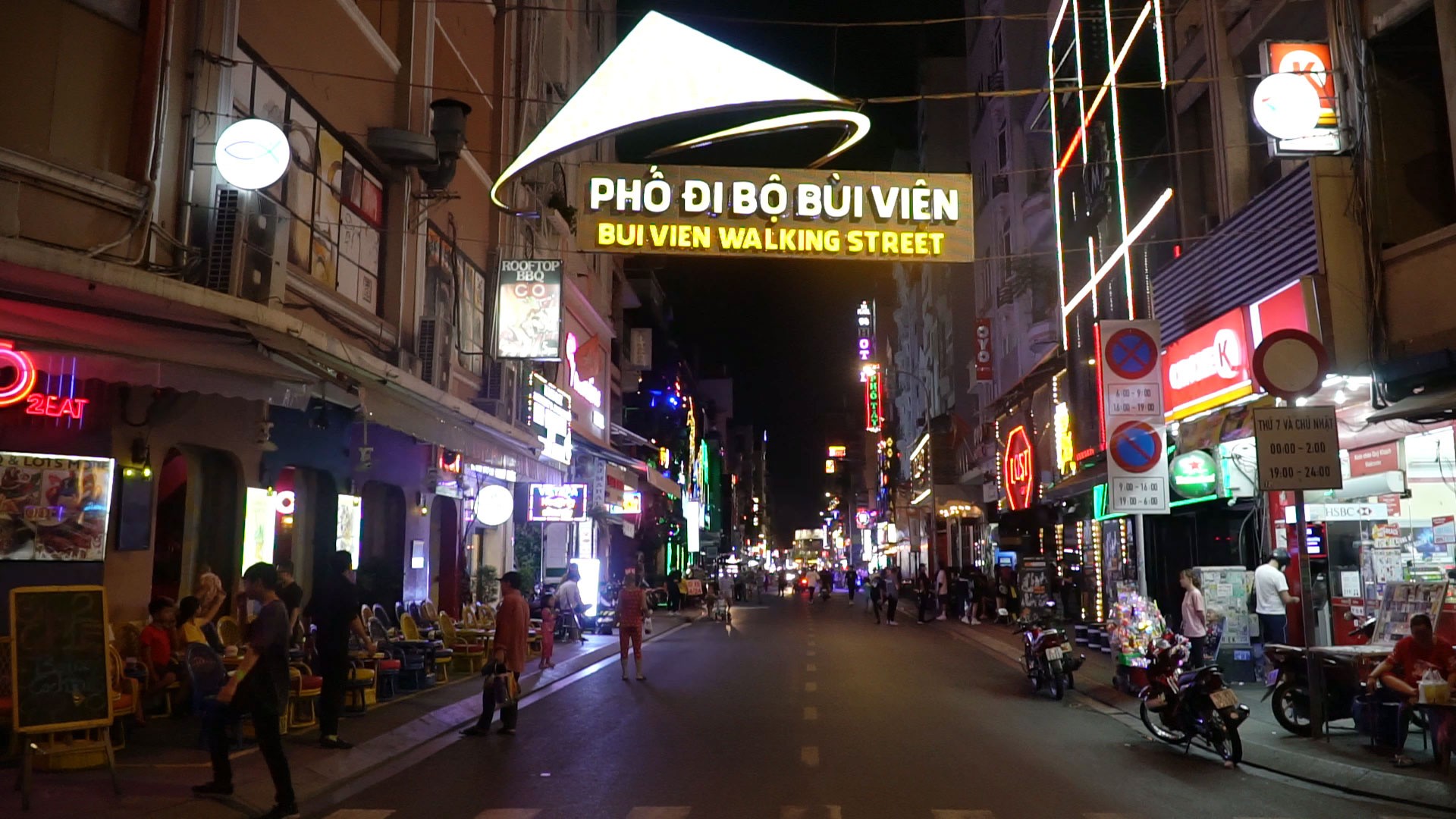
Bui Vien Street is often called West Street or Backpacker Street because it is frequently visited by foreign tourists . Bui Vien Street is an extremely attractive place with lots of bustling entertainment activities to feel all the soul of the sleepless city. This street operates all day but it gets the most crowded and bustling from 19:00 until 2:00. There are many restaurants, live music bars and pubs on both sides of the road that you can choose to enjoy the nightlife atmosphere.
7. Bitexco Tower
Address: Bitexco Financial Tower, 7, 2 Hai Trieu, Ben Nghe, District 1, Ho Chi Minh City
Opening hours: 8:00 – 23:00 daily

As the second tallest building in Ho Chi Minh City, Bitexco Tower is one of the city’s symbols and a photogenic location for tourists. The impressive thing about this building is its architecture as it was built like a lotus flower which is the national flower in Vietnam.
When coming here, you get an opportunity to enjoy cocktails on the rooftop bar, experience one of the fastest elevators in Southeast Asia as well as admire the beauty of Saigon from the observation deck. Saigon Deck, located on the 49th floor, is the perfect place for you to enjoy panoramic views of the city from above where you can see Notre Dame Cathedral, Thu Thiem Tunnel, and East-West Boulevard.
Saigon Skydeck tickets can be booked online here: Saigon Skydeck in Bitexco Financial Tower Admission Ticket.
8. Ben Thanh Market
Address: Located between Phan Boi Chau – Le Thanh Ton – Phan Chu Trinh – Quach Thi Trang Square, Ben Thanh Ward, District 1, Ho Chi Minh City
Opening hours: 7:00 – 23:00 daily
Entrance fee: Free

Going to a traditional market is one of the most popular things to do in Vietnam. Ben Thanh Market is considered to be one of the largest and oldest markets in Vietnam. Ben Thanh Market is a bustling market which is crowded not only by Vietnamese but also foreign tourists. Ben Thanh Market is open from morning to late night and you can find almost everything there. During the day the market sells fresh food, fashion, souvenirs. At night, the market mainly sells food and small handicrafts so tourists can buy gifts for family and friends.
Take this Vietnamese Cooking Class with locals so you can walk through the aisles of Ben Thanh Market and shop for the fresh ingredients you’ll need for class by yourself.
9. Saigon Book Street
Opening hours: 8:30 – 21:30 daily, on weekends open until 22:00
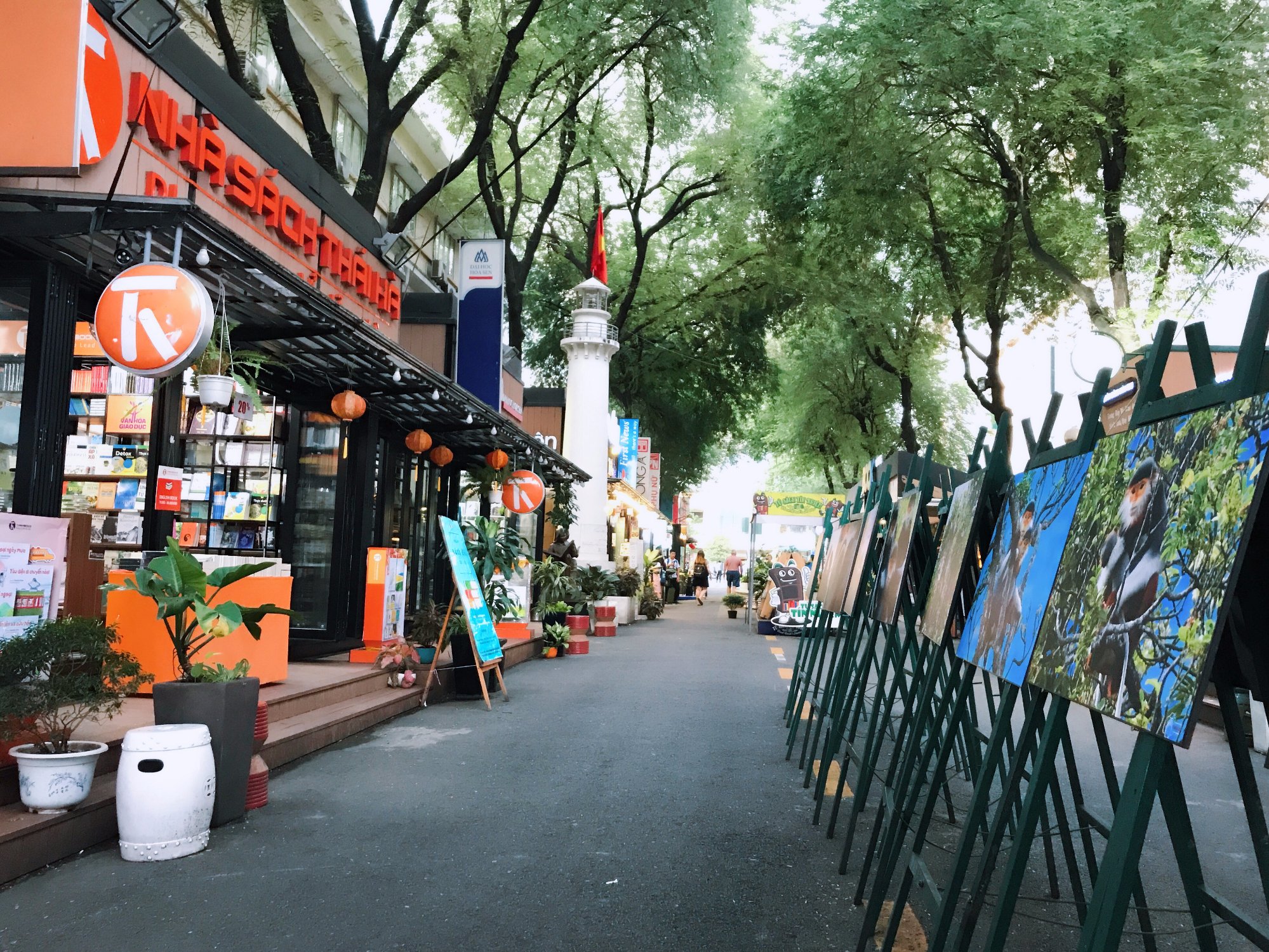
Saigon Book Street or Nguyen Van Binh Book Street is over 100 meters long between Hai Ba Trung Street and Notre Dame Cathedral in the heart of District 1 so it is often crowded during the day and night. Saigon Book Street was opened with the desire to improve the reading culture of young people in the city. There are more than 20 different bookstores and publisher shops with unique décor. Along with the famous bookstores, there is also a book display area and play area for children. If you are a book lover, you definitely cannot miss this street. You can come here and drop your soul into the pages of the book, enjoy coffee and relax.
10. Fine Arts Museum in Ho Chi Minh City
Address: 97 Pho Duc Chinh, Nguyen Thai Binh Ward, District 1, Ho Chi Minh City
Opening hours: 9:00 – 17:00 from Tuesday to Sunday
Entrance fee: 30,000 VND per person
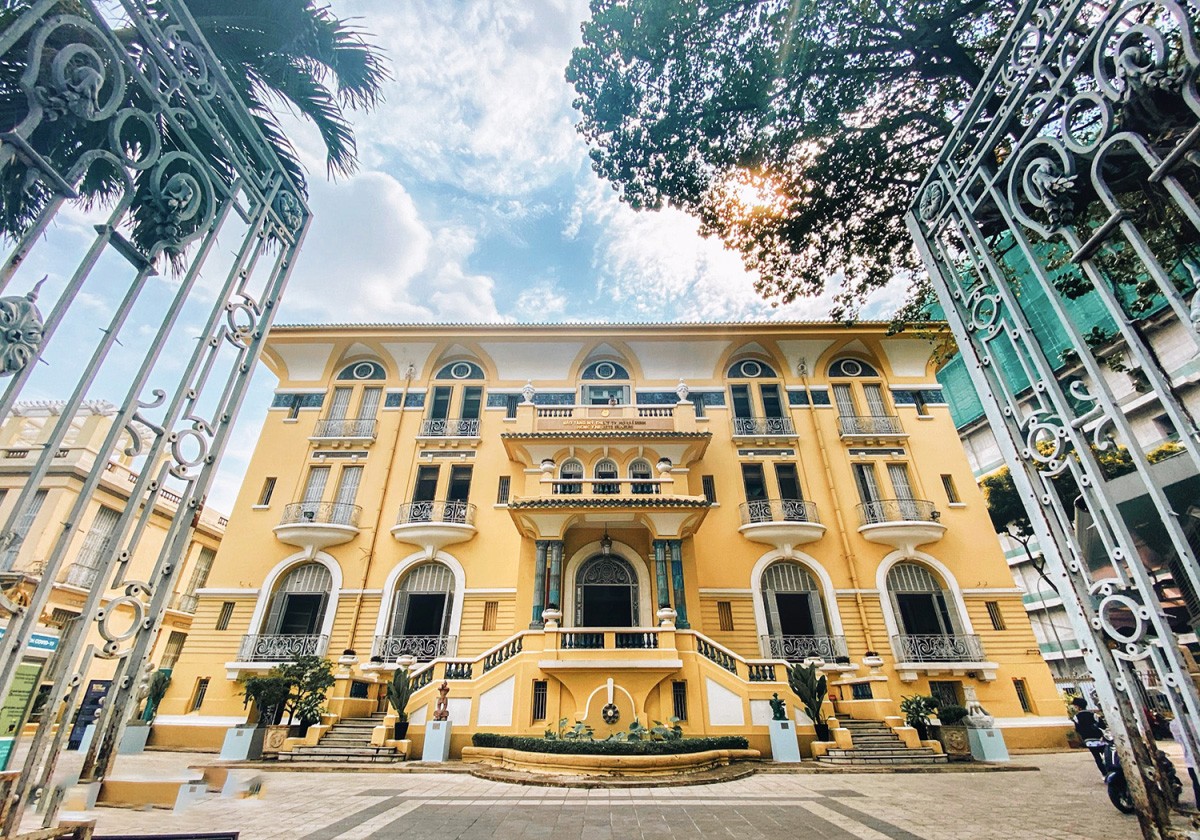
If you are an art lover, the Fine Arts Museum in Ho Chi Minh City is a good destination for you. Located in the heart of the city, the Fine Arts Museum is one of the largest art museums in Vietnam. The architecture of the museum building combines harmonious Asian and European styles. Previously, the museum was the private house of Hui Bon Hoa, also known as Uncle Hoa, who was considered the “king of real estate” of old Saigon. Currently, the museum has become a major art center of Vietnam, hosting many art works of painting, sculpture and antiques. This place opens up for the majority of students who study arts. There is also an art class to teach children how to draw.
